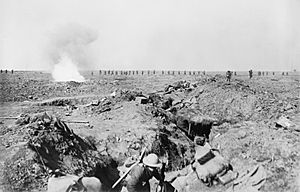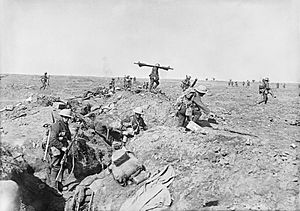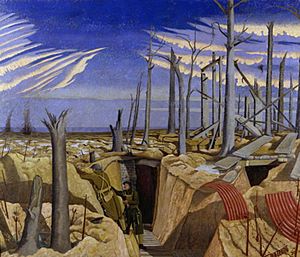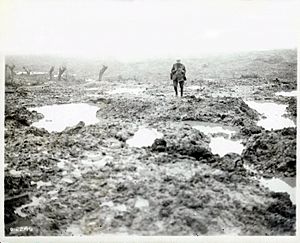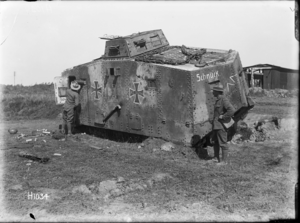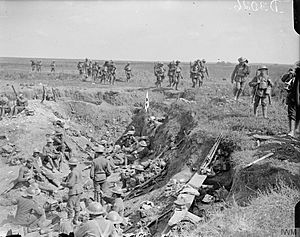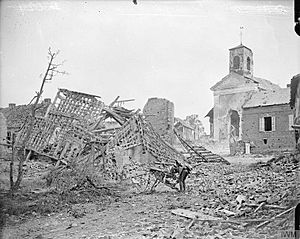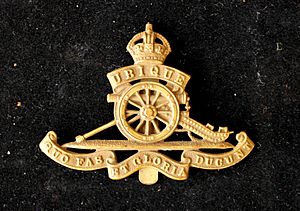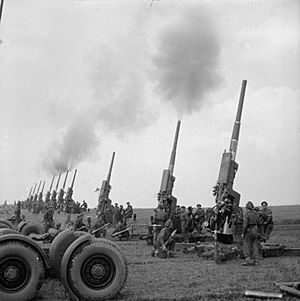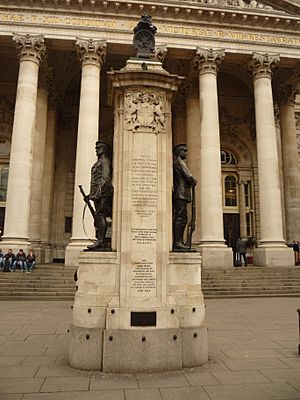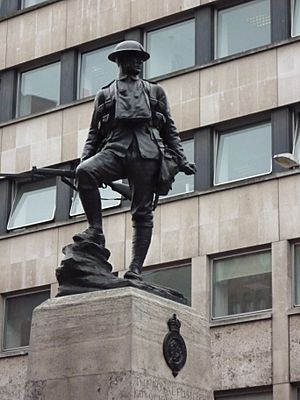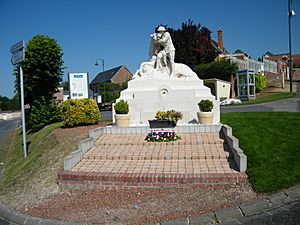4th (City of London) Battalion, London Regiment facts for kids
Quick facts for kids 1st Tower Hamlets Rifle Volunteer Brigade4th City of London Regiment 60th (City of London) Heavy AA Regiment |
|
|---|---|
| Active | 6 April 1860–1 May 1961 |
| Country | |
| Branch | |
| Role | Infantry Air Defence |
| Size | 27 Companies (1874) 4 Battalions (WWI) 3 Batteries (WWII) |
| Garrison/HQ | Shaftesbury Street, Hoxton (4th Londons) Bromley Road, Catford (60th HAA) |
| Engagements | Second Boer War WWI: 1st Bn:
2nd Bn:
WWII: |
The 4th (City of London) Battalion, London Regiment (Royal Fusiliers) was a special group of volunteer soldiers from East London. They were part of Britain's Territorial Army (TA). During World War I, this group grew to four battalions. They served in places like Malta and Egypt, fought in the Gallipoli and against the Senussi. They also saw heavy fighting on the Western Front, especially at Attack on the Gommecourt Salient in 1916, Bullecourt in 1917, and at Oppy Wood and Chipilly Ridge in 1918.
In World War II, the unit changed its role to anti-aircraft defense. They fought in the Battle of France and protected London during the Blitz in 1940. Later, they served in North West Europe in 1944–45. The unit continued to be part of the TA until 1961.
Contents
- Becoming a Volunteer Force
- Joining the Territorial Force
- World War I Service
- Between the World Wars
- World War II Service
- After the Wars
- Unit Traditions
- Special Leaders
- Memorials and Honors
- More Information Online
Becoming a Volunteer Force
In 1859, people in Britain worried about an invasion. This led to many local groups of volunteers forming. These groups were called Rifle Volunteer Corps (RVCs). The Tower Hamlets area of East London was very keen to join.
The 2nd (Hackney) Tower Hamlets RVC started on April 6, 1860. It quickly grew to seven companies. Another group, the 4th Tower Hamlets RVC, formed in June 1860. The 6th Tower Hamlets RVC started in September 1860.
In 1868, the 4th Corps and 2nd Corps joined together. They became the 1st Tower Hamlets Rifle Volunteer Brigade (THVRB). This new group had 15 companies. Later, in 1874, the 6th Corps also joined the 1st Tower Hamlets. This made the group very large, with 27 companies at first. Their main office moved to Shaftesbury Street in Hoxton. Their badge showed the White Tower of the Tower of London. They wore bright red uniforms.
The THVRB helped in the 2nd Boer War. Some volunteers from the battalion fought there. Because of this, the battalion earned a special honor called South Africa 1900.
In 1904, the THVRB became part of the Royal Fusiliers. Their name changed to the 4th Volunteer Battalion, Royal Fusiliers.
Joining the Territorial Force
In 1908, the Territorial Force (TF) was created. This was a new way to organize volunteer soldiers. The 4th Volunteer Battalion of the Royal Fusiliers became the 4th (City of London) Battalion, the London Regiment (Royal Fusiliers). People often called them the '4th Londons'. They were part of the 1st London Brigade. This brigade was part of the 1st London Division of the TF.
World War I Service
Getting Ready for War
On August 2, 1914, the 1st London Division was on its way to a training camp. But they were quickly called back to London. War was about to start. By August 3, the 4th Londons were ready. Before war was declared on August 4, they were already guarding important railway lines. The 4th Londons protected the line from Waterloo to Farnborough, Hampshire.
On September 4, the 4th Londons left for Malta. They were going to do guard duty overseas. Some soldiers who couldn't go overseas stayed behind. They started recruiting new soldiers. This new group became the 2/4th Londons. The original unit was then called the 1/4th Battalion. Later, two more battalions, the 3/4th and 4/4th, were also formed.
1/4th Battalion's Journey
Malta and France 1914-1915
The 1/4th Londons were among the first volunteer units to serve overseas. They arrived in Malta on September 14, 1914. They guarded the coast and trained new recruits. In January 1915, they left Malta for Marseilles in France.
After getting new rifles and equipment, the 1/4th Londons joined the 3rd (Lahore) Division. They soon faced their first trench warfare near Neuve Chapelle.
Fighting at Ypres
On April 22, 1915, the Germans attacked Ypres using poison gas. The 1/4th Battalion marched quickly to the Ypres Salient. They entered the battle on April 26. They came under heavy fire and suffered many losses. Between April 26 and 30, the 1/4th Londons lost 365 out of 600 men.
After this, the battalion spent the summer of 1915 holding trenches. They also did hard labor. They suffered more casualties from sickness in the trenches.
Joining the 56th Division
In February 1916, the battalion joined the 56th (1/1st London) Division. This division was getting ready for its first big operation. In May and June, many experienced soldiers from other battalions joined the 1/4th Londons. This brought them back to full strength.
The Battle of Gommecourt
The 56th Division was part of the Attack on the Gommecourt Salient at the start of the Battle of the Somme. The 1/4th Battalion dug new trenches very close to the enemy. They worked for weeks, often at night.
On July 1, the attack began. The 1/4th Londons moved forward under heavy German shelling. Many soldiers were lost trying to cross No man's land. The battalion suffered 50 percent casualties, even though less than half of them left their own lines. The attack was a diversion and did not succeed. The remaining soldiers had to hold their line for weeks.
Battles on the Somme
On September 5, 1916, the 56th Division returned to battle during the Battle of Ginchy. The 1/4th Londons led an attack on September 9. They followed a new type of artillery attack called a 'creeping barrage'. They captured their objectives, but both sides of their attack were exposed. They suffered about 270 casualties.
For the Battle of Flers–Courcelette on September 15, the 1/4th Londons were meant to follow another attack. But mud and German shelling slowed them down. The attack was called off. On September 25, during the Battle of Morval, the 1/4th Londons attacked again. They cleared the northern part of Bouleaux Wood with little resistance. This was a successful operation with only 32 casualties.
The battalion then fought in the Battle of Le Transloy on October 7. They attacked, but were met by strong German machine gun fire. They suffered 300 casualties and had to withdraw. The battalion was reduced to only 275 men. They spent months resting and rebuilding their strength.
Arras and Ypres 1917
In March 1917, the 56th Division prepared for the Battle of Arras. The Germans had retreated, but the attack still went ahead on April 9. The 1/4th Londons helped to secure the captured areas. On May 10, they successfully captured a German outpost called 'Cavalry Farm'.
In August 1917, the 56th Division moved to the Ypres area for the Battle of Langemarck. The 1/4th Londons attacked on August 16. They faced strong German defenses and suffered many casualties. Twelve officers and 182 other ranks were killed or wounded.
Cambrai and Reorganization
The division was weak after the Ypres fighting. On November 20, the 56th Division made a fake attack to distract the Germans during the Battle of Cambrai. The 1/4th Londons were in reserve. Later, they were involved in three days of fighting in the Hindenburg Line trenches, losing 60 men.
In February 1918, many battalions were combined due to a shortage of soldiers. The 1/4th Battalion received new soldiers from other London battalions. This helped them reorganize and become stronger.
Oppy Wood and the Hundred Days Offensive
On March 28, 1918, the Germans launched a big attack (Operation Mars). The 1/4th Battalion's outposts in Oppy Wood were heavily attacked. Two companies were overrun, but they caused many German casualties. The remaining soldiers held their ground, allowing others to retreat. The battalion lost 19 killed, 45 wounded, and 171 captured or missing.
The Allied counter-attack, the Hundred Days Offensive, began in summer 1918. The 56th Division joined the Battle of Albert on August 23. The 1/4th Londons attacked and captured the village of Boyelles. They continued to advance, capturing machine guns.
On August 28, they attacked again towards Bullecourt. They had to clear out stubborn German positions. On August 31, the 1/4th Londons helped clear Bullecourt village. They were happy to finally capture Bullecourt, where another part of their regiment had fought the year before.
On September 27, during the crossing of the Canal du Nord, the 1/4th Londons followed the main advance. They faced little resistance. The war was now a chase, with Germans retreating. On October 6, patrols from the 1/4th Londons entered Aubencheul-au-Bac without a fight.
The battalion was rested and returned to the front on November 3. They made good progress but met strong resistance at the Aunelle river. They were not involved in any more fighting before the Armistice on November 11.
The battalion was slowly sent home in early 1919. The last 50 men returned to England on May 21 and marched through London.
2/4th Battalion's Service
The 2/4th Battalion formed quickly in September 1914. They moved to New Barnet for training. In December, they were ordered to Malta to replace the 1/4th Battalion.
Malta and Gallipoli 1915
In Malta, the 2/4th Battalion continued training and guarded prisoners of war. In August 1915, they were sent to Egypt. In October, they landed at Gallipoli. They experienced trench warfare and suffered their first battle casualties. In December, they took over frontline trenches. Between December 31 and January 8, 1916, the battalion was evacuated from Gallipoli.
Senussi Campaign in Egypt
In Egypt, the battalion joined a force guarding the Nile River. They were protecting against attacks from Senussi rebels. The 2/4th Londons' commanding officer led a force at Beni Mazar.
In April 1916, the 2/4th was sent to Alexandria. On April 17, they sailed to Marseilles, France.
New 2/4th Battalion
In France, the 'Old 2/4th' Battalion was broken up. Its soldiers joined the 1/4th Battalion. Meanwhile, the 3/4th Londons, who were training in the UK, were renamed the 'New' 2/4th Battalion. This battalion became part of the 58th (2/1st London) Division.
In January 1917, the battalion went into the front line for the first time near Ransart. From February to April, the 58th Division followed the German retreat to the Hindenburg Line. They then worked to repair roads and railways.
Bullecourt and Ypres 1917
On May 13, the 2/4th Battalion relieved Australian soldiers at the Second Battle of Bullecourt. They faced heavy shelling and a serious German counter-attack. They suffered 250 casualties.
In August 1917, the 58th Division moved to the Ypres area. On September 20, in the Battle of the Menin Road Ridge, the 2/4th Battalion attacked. They captured their objectives quickly, but suffered severe casualties from shelling.
The division returned to the line for the Second Battle of Passchendaele on October 26. The weather was terrible, with heavy rain and mud. The soldiers struggled forward, but were pushed back. The battalion had 359 casualties, their costliest day. They had to be reorganized as a single company.
The 2/4th Londons spent a long time away from battle, getting new soldiers. In January 1918, the 58th Division moved south. They spent time digging new defenses.
Spring Offensive 1918
On March 21, 1918, the German spring offensive began. The 58th Division was positioned near the River Oise. The 2/4th Londons held their positions against four German divisions. They fought all day and held on until nightfall. They then withdrew across the Crozat Canal.
The German attack continued on March 22. The 2/4th Londons held the Vouel Line. By midday on March 23, they had to withdraw again. The battalion's fighting strength was down to about 120 men. A group of 280 clerks, cooks, and drivers from the brigade's rear areas joined them. This 'Grover's Force' helped block the German advance.
Villers-Bretonneux and Amiens
The 58th Division moved to cover Villers-Bretonneux. Between March 21 and April 4, the battalion lost 38 killed, 132 wounded, and 211 missing. New recruits joined them. On April 24, the 2/4th Londons were attacked by six German A7V tanks. They fought hard, causing heavy losses to the German infantry. An 18-pounder gun helped drive back the remaining tanks. The next day, a counter-attack regained most of the lost ground. The battalion lost 24 killed, 113 wounded, and 203 missing.
The battalion spent the summer of 1918 building defenses near Amiens. They received some new recruits, but were never at full strength. The 1918 flu pandemic caused more casualties than the Germans during this time.
For the start of the Hundred Days Offensive (Battle of Amiens) on August 8, 1918, the 2/4th Battalion advanced. In the morning mist, they went off course. They were stopped by machine gun fire and dug in.
On August 9, the division made a second attack on Chipilly Ridge. The 2/4th Londons attacked in the center. They faced heavy fire and suffered serious casualties. They dug in for shelter. Later that night, other units managed to clear Chipilly village. The battalion lost another 300 men in this battle. They received many new officers and soldiers to rebuild their strength.
Bapaume and Disbandment
The Second Battle of Bapaume began on August 22. On August 25, the 2/4th Londons were sent forward as an advanced guard. They marched along a road until they met the enemy. They attacked and secured their position by the end of the day.
On August 27, the attack continued. The 2/4th Bn helped clear the village of Maricourt. On September 1, they made a dawn attack towards Bouchavesnes. They followed the artillery barrage and reached their objective by 10:45 AM. This was their most successful action.
After a period of rest, the 2/4th Battalion attacked again on September 10 towards the villages around Épehy. They met strong resistance. This was the battalion's last action. Due to a shortage of soldiers, the remaining men of the 2/4th Battalion were combined with the 2/2nd Londons on September 12, 1918.
3/4th and 4/4th Battalions
The 3/4th Battalion was formed in Hoxton from volunteers. It began sending new soldiers to the 1/4th Battalion as early as April 1915. This battalion later became the 'New' 2/4th Battalion.
The 4/4th Battalion was formed in June 1915. Its job was to train new soldiers and wounded men returning to service. It had instructors who were former soldiers and police officers. In April 1916, its name changed to 4th (Reserve) Bn, London Regiment. In September 1916, it was combined with another reserve battalion.
Between the World Wars
The battalion reformed in the Territorial Army on February 7, 1920. It was renamed 4th City of London Regiment (Royal Fusiliers).
In 1935, Britain needed more anti-aircraft (AA) defenses. The 4th Londons changed their role to AA artillery. On December 15, 1935, they became the 60th (City of London) AA Brigade, RA (TA). Their main office moved to Catford. They adopted the badge of the Royal Artillery.
In 1939, the AA units were renamed. The 60th (City of London) AA Brigade became the 60th (City of London) AA Regiment.
World War II Service
Getting Ready and France
The TA's AA units were called up on September 23, 1938, during a crisis. They quickly took their positions. In February 1939, a new Anti-Aircraft Command was formed. On August 24, 1939, before war was declared, AA Command was fully ready. The 60th AA Regiment had a mix of old and new guns.
On October 10, 1939, the regiment moved to France. They had 24 guns and joined the British Expeditionary Force (BEF). They defended six airfields near Abbeville.
When the Battle of France began in May 1940, the BEF was forced to retreat. The 60th HAA Regiment fought hard. One battery, the 169th, was attacked by tanks and aircraft and had to destroy its guns. By May 25, the regiment was constantly fighting at Dunkirk. They protected the evacuation of the BEF. As the area shrank, the AA units destroyed their guns and joined the queues to leave.
Defending Britain: The Blitz
AA units returning from France were quickly re-equipped. The 60th HAA Regiment went to Aberystwyth and got new guns. In the summer of 1940, they were called a Heavy AA Regiment.
They joined the 34th (South Midland) AA Brigade. Their job was to protect Birmingham and Coventry. These cities were heavily attacked during The Blitz, which lasted until May 1941.
Some parts of the regiment were sent to other units. By September 1941, the 60th HAA Regiment had moved to Scotland. They were now protecting the Firth of Clyde.
Becoming a Mobile Unit
In early 1943, the 60th HAA Regiment became a mobile unit again. This meant they could move and fight wherever needed. They had three batteries: 168 HAA Bty, 169 HAA Bty, and 206 HAA Bty.
Normandy and Beyond
The regiment was assigned to the Second Army for the Allied invasion of Normandy (Operation Overlord). They were supposed to land after D-Day to defend airfields.
They started landing on June 10 (D + 4). However, German air attacks were lighter than expected. The HAA guns were not needed as much for air defense.
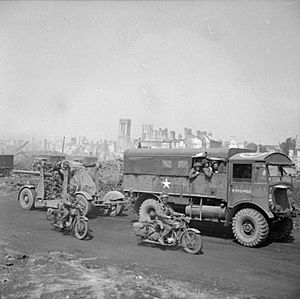
So, the HAA guns started being used for ground tasks. They fired at enemy positions, helped against tanks, and supported infantry. The 60th HAA Regiment did this during the Battle of Caen. After Caen was captured, they defended the city from air attacks.
Fighting in North West Europe
After the Allies broke out of Normandy, the 60th HAA Regiment guarded the crossings of the Seine River. Then they moved to Boulogne on September 12. They helped the II Canadian Corps attack the German soldiers holding the port. Their 3.7-inch guns fired for a long time. The guns got so hot they bent!
In November, the brigade defended the Waal bridges at Nijmegen. These bridges were captured during Operation Market Garden. The HAA regiments also fired at V-1 flying bombs flying towards Antwerp.
In December, the weather was bad, with lots of flooding. On December 17, the German air force attacked. On January 1, 1945, the German air force launched a big attack called Operation Bodenplatte. They attacked Allied airfields and supply lines. The 60th HAA Regiment's guns fired 15 times at enemy planes.
For operations in the Reichswald in February 1945 (Operation Veritable), the 60th HAA Rgt helped with bombardments. As the war ended, the regiment continued to protect important routes.
The regiment was chosen to fire a special salute on May 6, 1945. This was to celebrate Victory in Europe. The regiment was officially put on hold on April 3, 1946.
After the Wars
The regiment reformed in the TA on January 1, 1947. It was called 460 HAA Regiment, RA (City of London). Its main office was in Catford.
In 1955, many AA units were reduced. The 460 HAA was merged into another regiment. It became R Battery (4th City of London). In 1961, there were more mergers. The 4th Londons' history as a separate unit ended.
Unit Traditions
The 4th Londons liked to say they came from old London citizen soldier groups. But there was no real link.
During World War I, the 1/4th Londons would have a daily ceremony with drums. The 3/4th (later 2/4th) Battalion had a Pipe band. This band helped them get new recruits. The pipers wore a special Scottish tartan and hats. The battalion believed they were the only English unit without Scottish or Irish ties to have such a band.
After World War II, officers and senior non-commissioned officers of the 460 HAA Rgt wore a red and blue twisted cord on their uniform.
Special Leaders
Here are some of the special leaders who served as Honorary Colonel for the unit:
- Sir Henry de Hoghton, 9th Bt (from 1864)
- R. Richardson Gardner (from 1865)
- Walter Mellor (from 1867)
- Lt-Gen G.H. Moncrieff (from 1886)
- Lord Marshall of Chipstead, who was Lord Mayor of London (from 1918)
- Lt-Col Sir Leslie Burnett, 2nd Bt, a former commanding officer (from 1936)
Memorials and Honors
The 4th London Battalion is remembered on the City and County of London Troops Memorial. This memorial is in front of the Royal Exchange. One of the bronze statues on it shows an infantryman, representing London's infantry units.
The battalion is also listed on the Royal Fusiliers War Memorial at Holborn Bar. This memorial has a bronze statue of a Fusilier. The names of those who died in World War I are listed at the Royal Fusiliers Chapel.
The 58th Divisional Memorial is at Chipilly. It shows a wounded horse. This memorial was paid for using money from the division's entertainment canteen.
The 4th London Regiment received many special honors for their bravery in battle. These are called Battle honours. Some of the most important ones include: South Africa, 1900 Neuve Chapelle, Ypres, 1915, '17, Aubers, Festubert, 1915, Somme, 1916, '18, Arras, 1917, '18, Bullecourt, Langemarck, 1917, Cambrai, 1917, '18, St Quentin, Villers Bretonneux, Amiens, Canal du Nord, Sambre, Gallipoli 1915–16, Egypt, 1916.
The honors in bold are those that were chosen to appear on the regiment's special flags. The Royal Artillery does not get battle honors, so the 60th HAA Regiment did not receive any for World War II.
More Information Online
- British Army units from 1945 on
- British Military History
- The Long, Long Trail
- Orders of Battle at Patriot Files
- David Porter's work on Provisional Brigades at Great War Forum
- The Regimental Warpath 1914–1918 (archive site)
- Land Forces of Britain, the Empire and Commonwealth (Regiments.org – archive site)
- Royal Artillery 1939–1945
- Royal Artillery Units Netherlands 1944–45


